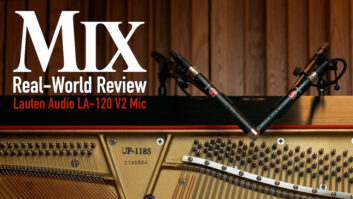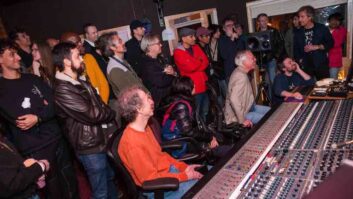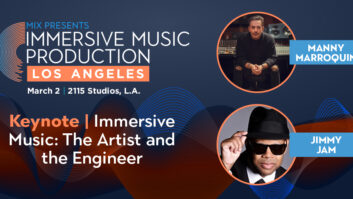Soundmirror’s Mark Donahue (left) and Blanton Alspaugh traveled to LA to capture performances with a slate of gear from SmartAV, Lectrosonics, Merging Technology, Schoeps, DPA and Neumann. LOS ANGELES, CA—Soundmirror, based in Boston, MA, took up residence in Los Angeles during February at the Dorothy Chandler Pavilion, one of four venues on the downtown Music Center campus, to capture the LA Opera’s latest production for release by Dutch classical music label Pentatone. The recording, of composer John Corigliano’s The Ghosts of Versailles, commissioned in 1991 by the Metropolitan Opera, was notable for its use of the first 13 LT Digital Hybrid Wireless bodypack transmitters to come off the Lectrosonics production line.

“We’re using 24 DPA 4071 [lavalier] microphones with Lectrosonics transmitters and Venue receivers,” says Soundmirror’s Blanton Alspaugh, a four-time Grammy Award-winner, including one for Producer of the Year, Classical in 2012. The production utilized 11 Lectrosonics SMQV transmitters in addition to the 13 new LT bodypacks with the DPA lavs.
The DPA mics were affixed at each performer’s wigline, protruding approximately one-quarter inch. Soundmirror recording engineer Mark Donahue, with five Grammy Awards to his credit, comments, “Those 4071s are designed for hairline applications. They have the right boost on them, so they sound natural at that position.”
Donahue continues, “The 24 wireless get paired up with another 30-something mics in the [orchestra] pit, and another 15 or so mics on the stage and buried in the set. All of that goes into Merging Horus interfaces. Those all come out on a piece of Cat 5 and get recorded on a couple of computers.” The stage mics, all Schoeps, included CMIT shotguns with MK 21 capsules positioned by the footlights.
The wireless channels were providing additional vocal intelligibility to the zone mics, according to Donahue. “You still get the stereo of the zone miking and the proper perspective on stage. I don’t pan the wireless mics—they all go into the center and add a little bit of dialogue clarity.”
Massachusetts-based independent RF expert David Williams, the third member of the Soundmirror team, was managing the Lectrosonics wireless gear, including three Venue receivers. “It was really nice to have the LT,” says Williams, since the new transmitter tunes across a wide 75 MHz range. “We planned on eight, eight and eight [channels] in three separate blocks: 21, 22 and 23. But I got a phone call from the Bexel guy a week ago saying you are SOL for block 23. He found six channels for
us, but that meant we had to put 10 channels in block 22. The SMQVs are locked into a block but the LTs have that three-block range,” so they could be tuned accordingly.
Located in a trailer temporarily located at the venue’s loading dock, Alspaugh and Donahue were essentially performing QC as each performance was lectrosonics.com recorded. “We’re listening for audio quality issues. We sit here in the fabulous ‘audio palace’ and monitor it all,” laughs Donahue.
The SmartAV Tango control surface was set up with the 24 wireless mics plus eight VCA groups, for re-balancing the orchestra, immediately at hand. “As Blanton is marking the score, he’s giving me on/off cues [for the RF channels]. There are certain groups that happen together, but there’s no way to set up mute groups for it—people leave the scene and come back. It’s like whack-a-mole.”
Alspaugh and Donahue were monitoring through a 5.1 setup of Neumann KH 120 speakers. “Our normal speaker complement is B&W 801s; we’ve been using those for 30 years,” says Donahue. “But the Neumann is a great small monitor.”
Ordinarily Soundmirror would have recorded the production to DXD format, says Donahue, but the unusually large number of wireless mic channels exceeded the 64-channel transport capabilities at that sample rate, so they elected to track the 80 channels at 192 kHz. “We’re recording to [Merging Technologies] Pyramix. We have two systems, plus I’m running a laptop—which we modified to take a PCI card—with RAVENNA, as a backup.”
LA Opera’s The Ghosts of Versailles—the West Coast premiere and the first full-scale U.S. production since 1995—was running for six performances in repertory with the two classic “Figaro” operas that inspired it, The Barber of Seville and The Marriage of Figaro. “We’re capturing three performances,” explains Alspaugh. “Then we’re going to need 140, 150 hours of editing, mixing and mastering. That will be spread out over months. You’ve got to send copies to the composer, the conductor; you fit it into everybody’s schedule and pretty soon you’re halfway through the year.” According to Pentatone label founder Jop Maarse, also in attendance, the hybrid SACD release can be expected in 2016.
Donahue adds, “This is a cooperative production. There’s the production at the front of the house—the normal archiving production—then our production is laid on top of that. There are a whole bunch of mics that are split between the two of us, and then there are a bunch of mics that just go to the truck.
“We have the easy job; this man,” Donahue says, indicating Jeff Kleeman, LA Opera’s technical director, “has the hard job. We just try and stay out of the way.”
Lectrosonics
lectrosonics.com
Soundmirror
soundmirror.com







